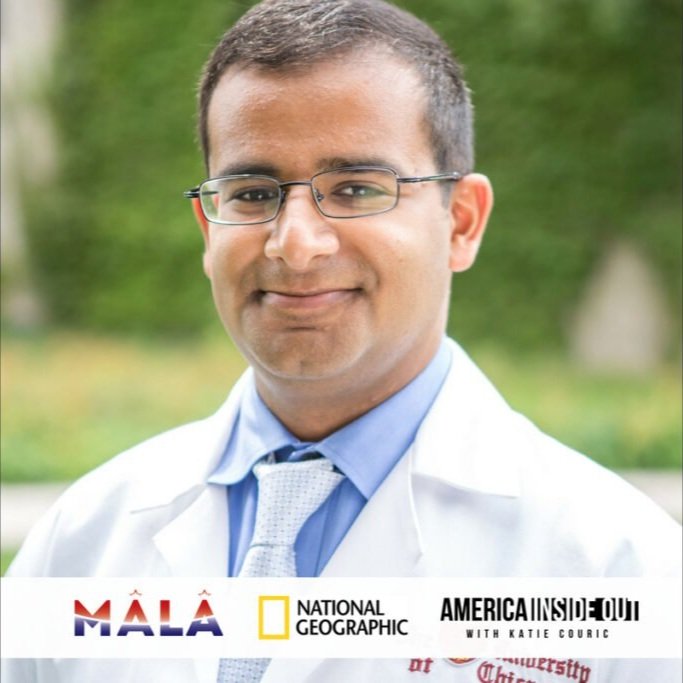Aamir Hussain: Shanti and Salaam
To spotlight and amplify Muslim American voices, join MALA’s campaign to elevate public dialogue on Muslim-American identity in the 21st Century. In the spirit of this inspiring episode and series, share your story with us: what is it really like to be Muslim in America? Selected stories are shared by MALA and National Geographic.
I was once asked, “What was your first memory of religion?” Being an American-born Indian Muslim having grown up near New York City, you might expect me to say “9/11.” However, my first memory relates to the interplay between Hinduism and Islam, two of the biggest faith traditions among South Asians.
I grew up in Farmington, an affluent, predominantly white town in suburban Connecticut. My dad was a doctor, and his colleagues’ children became my only Indian friends in our area. They were Hindu, and we were Muslim, but I didn’t think much of this at first. I learned about religion from my parents and extended family during early childhood.
Given the small number of Muslims in the area when I was a child, my family tried sending me to an Islamic Sunday school. The conversation that occurred a few weeks later was my first memory of religion.
I came back from Islamic school one day, and announced to my parents that I was planning to convert my few Hindu friends to Islam. Their first reaction was disbelief.
While teaching me Muslim beliefs as a child, they had always emphasized the value of religious diversity, and used the metaphor that every religion was a path attempting to reach the same destination of ethics, social justice, and community.
It turned out that my teachers at Sunday school did not share this belief; in their paternalistic view, religions other than Islam were incorrect, and converting a non-Muslim to Islam would be doing them a favor.
My parents quickly understood that my 6-year-old self was motivated by a desire to help my other Indian friends, and that I did not realize the implications of suggesting that they change their religion.
My mother said, “OK, if your friend asked you to worship one of the Hindu gods, would you do it?”
I said I would not.
She continued, “Then how do you think they will feel if you ask them to pray to Allah? Nobody has a right to tell another person how to pray.”
This satisfied my 6-year-old self, and I would later learn that this philosophy came directly from the Quran. One Quran verse mentioned in the Aziz Ansari TV series “Master of None” says, “I do not worship what you worship, and you do not worship what I worship. To each their own religion.” I credit my mother for coming up with an explanation that neatly summarized Islamic ethics, while encouraging me to think about the situation from the other person’s perspective.
Needless to say, that was the end of my time in that Islamic school, and the last time any of us ever brought up converting others.
However, that was only the beginning of my interfaith experiences. Even before 9/11, my family understood the importance of engaging with people of other religions. We would always invite our Jewish, Christian, Hindu, and nonreligious friends to our house for Eid celebrations, and all of them would return the favor on their holidays. After 9/11, we became even more invested in interfaith activities, and I helped edit my school’s curriculum about Islam to ensure accurate representation.
I became especially interested in Hinduism during a visit to India, where I read tales of Hindu deities written in the style of superhero comic books. While some of my relatives balked, my parents encouraged me to learn as much as possible about other traditions. This brought me closer to many of my Hindu friends, even as they began to drift away from religion later in their lives.
When I began college at Georgetown University, I was eager to continue the interfaith experiences that I had as a child. However, I quickly realized that Hindu-Muslim interfaith dialogue would be challenging. For starters, Georgetown was a Jesuit institution, and chose to focus its interfaith efforts on Judaism, Christianity, and Islam due to their historical similarities. And frankly, Hindu and Muslim South Asians around the world hold deep-rooted prejudices about each other, and often ostracize those who attempt interfaith conversations.
My friends and I were eager to push the interfaith envelope at Georgetown to have some sort of Hindu-Muslim dialogue. There was clearly interest among the student body; South Asian students at Georgetown were already good friends and interacted constantly during our annual cultural show. While hesitant to discuss religion on their own, they were excited about a facilitated dialogue led by fellow students.
Working with leaders of both the Hindu and Muslim student groups on campus, we developed an interfaith dialogue program called “Shanti and Salaam”. Shanti means “peace” in Sanskrit, and Salaam means “peace” in Arabic. Given that the theological differences and historical issues between Hinduism and Islam could provoke controversy, we decided to focus our dialogue around ethical and cultural topics instead.
“Shanti and Salaam” consisted of small-group facilitated discussions, bookended by speeches from faith leaders in each tradition about the importance of interfaith dialogue. The event was a huge success, and has become a staple of interfaith programming at Georgetown for the past give years. The students felt that they had grown closer to their friends from other faith traditions by discussing these more personal topics.
I realized that my identity as an Indian Muslim made me a “cultural bridge” of sorts between the majority of Indians who are Hindu and American Muslims, who consist of a wide array of ethnic groups. I credit my parents for refusing to give into tribalism and religious paternalism, and encouraging me to respect and learn about other religions.
In the era of Trump, South Asians of all faith traditions face similar challenges of bigotry and discrimination. As a community, it is important for us to come together around areas of common interest, and help turn the page on prejudices that began before many Millennials even arrived in the United States. There is definitely an appetite for more Hindu-Muslim dialogue in universities. In fact, just a few months ago, the Muslim and Hindu student associations at my medical school, the University of Chicago, hosted a similar event that also drew a large crowd.
In the future, I look forward to seeing more bridge-building, more peace, and more interfaith understanding among South Asians in the United States.


